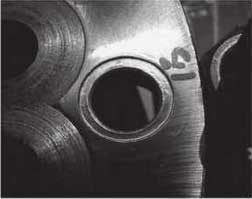Differential housing inspection
(1) Hardness: 207HB. Metallographic structure is pearlite + reticulate ferrite. Grain size is more uniform. A few grains are finely crushed and normalized.

(2) Installation hole of differential housing 16 x 13: there is no abnormal chamfer of the installation hole, the surface of the hole and the bolt mating part are pressed out of the dent, the average step depth is 0.24mm (max. 0.34 mm, min. 0.14 mm), and the average deformation contraction of 16-_13 is 0.21 mm (max. 0.38 mm, min. 0.08 mm), compression deformation.
(3) Differential case has low hardness, compressed and deformed screw holes, which easily causes loose secondary helical gears, offset load and other problems.
Secondary helical teeth fixed
(1) Effective length: Effective depth of large screw mounting threaded hole is more than 20m, but M12 x 1.25 x 25-10.9 bolt selected for differential housing mounting bolt has effective turning length of only 10m. The selected length is not reasonable. According to experience, effective turning length should reach 15m.

(2) The hardness of 37HRC (about 341HB) meets the requirements of HRC (32-39). The screw teeth are partially decarburized and the height of decarburized layer is 1/4H (1 < 2/3H1), which meets the requirements. The metallographic structure is tempered flexite with normal structure.
(3) The hardness of bolts is 134H B higher than that of differential case and stop ring. Excessive hardness difference is likely to cause deformation or wear of differential case and stop ring.
